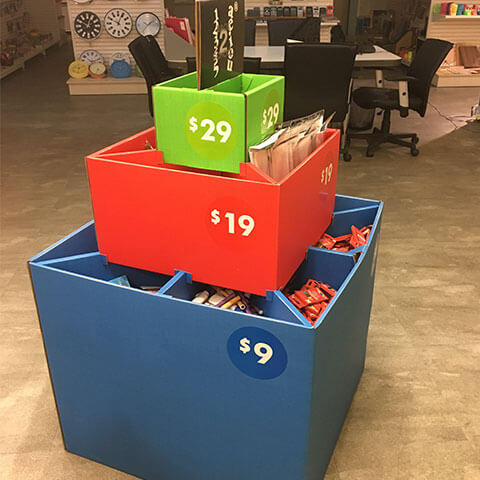Designing an effective cardboard display isn’t just about creativity—it’s about functionality and purpose. A well-designed display can grab attention, showcase your product, and drive sales. However, some common mistakes can undermine your display’s potential. Let’s dive into the key errors to avoid when designing your next cardboard display.
1. Ignoring the Target Audience
One of the biggest mistakes you can make is designing a display that doesn’t speak to your audience. Every product has a specific customer in mind, and your display should reflect that. Whether your target is children, young adults, or professionals, the design, colors, and messaging need to resonate with them. For example, a display for eco-friendly products should incorporate natural, earthy tones and sustainable messaging, while a tech product display might lean towards sleek, modern, and high-tech aesthetics.
2. Overcrowding the Display
More isn’t always better. When designing your cardboard display, it’s easy to think that more products or information will attract attention. However, overcrowding can have the opposite effect. A cluttered display can overwhelm potential buyers and distract from your product’s main features. Keep it simple. Focus on the key message and make sure there’s enough white space for the product to shine.
3. Neglecting Brand Consistency
Your display should align with your overall brand identity. Using random colors, fonts, or imagery that don’t match your branding can confuse customers and make your display seem disjointed. Consistency builds trust and recognition. Always ensure that your cardboard display reflects the same look, feel, and tone as your website, packaging, and other marketing materials. This helps create a cohesive brand experience that feels familiar to customers.
4. Ignoring the Placement and Visibility
A cardboard display may look fantastic from one angle, but what about the other sides? When designing a display, consider how it will be viewed from various angles. A great design might be invisible if placed in the back of a store or on a low shelf. Ensure your display is designed for 360-degree visibility, and think about where it will be placed in the store for maximum impact. Keep in mind that your product needs to be easy to reach and highly visible.
5. Forgetting About Durability
Cardboard displays need to be sturdy enough to hold products while maintaining their aesthetic appeal. Failing to consider durability can result in displays that collapse or wear out too quickly. When designing your display, choose high-quality materials and ensure your design incorporates reinforcement where needed. This will not only make your display more functional but will also give it a more polished, professional look.
6. Overlooking the User Experience
The goal of a cardboard display is not just to look good but also to make the shopping experience easier for consumers. Think about how customers will interact with your display. Is the product easy to grab? Are instructions or pricing information clearly visible? Avoid complex designs that may confuse customers, and opt for displays that are user-friendly and facilitate a seamless shopping experience.
7. Neglecting to Test the Display
Before mass-producing your cardboard display, it’s critical to test it. A prototype can help you assess whether the display works as intended in a real-world retail environment. Does it hold up under weight? Does it grab attention from a distance? Does it allow for easy product interaction? Testing ensures that your design is both practical and effective.
8. Failing to Integrate Functional Elements
A good display isn’t just about aesthetics—it also needs to be functional. Think about adding features that improve the usability of the display, such as hooks for hanging items, shelves for stacking products, or clear slots for brochures or price tags. Functional elements can make your display more practical and help highlight specific features of your product.
9. Underestimating the Importance of Lighting
Lighting can dramatically enhance the appeal of your cardboard display. While cardboard itself is neutral, adding strategic lighting can make your product stand out. Simple, low-cost solutions like spotlights or LED strips can draw attention to key products or messages. Just be sure not to overdo it—lighting should highlight your display, not overwhelm it.
10. Ignoring Environmental Impact
Consumers today are more eco-conscious than ever. If your display isn’t designed with sustainability in mind, you risk alienating a growing market. Consider using recyclable or biodegradable materials for your cardboard display. Also, try to design your display in a way that minimizes waste during production and shipping. Being environmentally responsible can enhance your brand’s reputation and attract eco-conscious customers.
11. Not Considering the Cost of Production
Lastly, it’s important to keep the cost of production in mind. While you may have grand ideas for your cardboard display, it’s essential to stay within budget. Overly complex designs or high-end materials can increase costs quickly. Strike a balance between design quality and cost-effectiveness, ensuring that the display provides value without breaking the bank.
Conclusion
Designing a successful cardboard display requires more than just creativity; it’s about aligning aesthetics with functionality. By avoiding these common mistakes—such as neglecting the target audience, overcrowding the display, or overlooking durability—you can create a display that not only grabs attention but also boosts sales. With careful planning and thoughtful design, your cardboard display can make a lasting impression in retail spaces and drive results.


